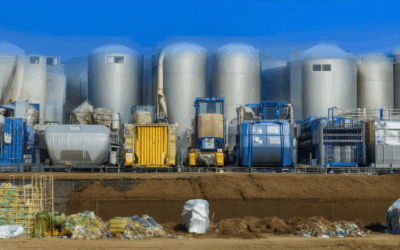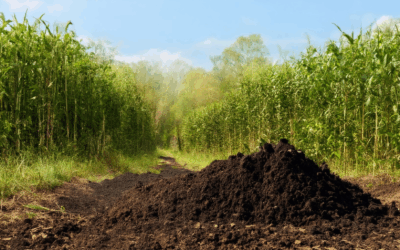As global demand for sustainable solutions continues to rise, the exploration of renewable carbon-sequestering materials has become a cornerstone of innovative environmental strategies. These materials play a pivotal role in reducing the carbon footprint of buildings, infrastructure, and industrial processes, offering a pathway toward a more sustainable future. By harnessing the power of natural and engineered solutions, professionals and enthusiasts alike are discovering effective ways to mitigate climate change through carbon sequestration. From natural processes to cutting-edge technologies, the article delves into the best practices and materials that can make a tangible difference. Whether you’re looking to learn about carbon-negative materials or seeking insights into low embodied carbon solutions, this comprehensive guide provides essential information to navigate the world of renewable materials and their role in fostering a healthier planet.
Key Takeaways
- Explore a variety of carbon-sequestering materials to suit diverse needs for a sustainable future.
- Industrial sorbents like activated carbon are highly effective for capturing CO2.
- Biological materials, particularly algae, show promise in rapid carbon absorption.
- Emerging materials such as MOFs and zeolites offer innovative solutions for carbon capture.
- These materials find application across sectors, from energy to agriculture.
- Understand natural carbon absorption methods, including rock mineralization and soil sequestration.
- Biochar stands out as a versatile and effective carbon-storage solution.
- Marine ecosystems contribute to blue carbon initiatives for coastal carbon sequestration.
- Key materials for carbon storage include plants, concrete, steel, and biochar.
- Prioritize renewable and sustainable materials to drive a greener, more sustainable future.

What Are Carbon Sequestration Materials?
Carbon sequestration materials are innovative building products designed to capture and store atmospheric carbon dioxide (CO₂) throughout their lifecycle. These materials play a crucial role in reducing the carbon footprint of structures by actively absorbing CO₂ from the air, thereby contributing to global efforts in combating climate change.
How Do They Work?
These materials typically integrate advanced technologies or processes that allow them to absorb CO₂ during manufacturing, installation, or even after being used in construction. One prominent example is biochar, a carbon-rich material produced through pyrolysis of organic waste, which can effectively sequester CO₂ over its lifespan.
Examples of Carbon Sequestration Materials
- Biochar: Produced via pyrolysis, biochar is known for its high carbon content and ability to store CO₂. It is often used in agricultural soils to enhance fertility and sequester carbon.
- Concrete Additives: Some concrete mixes incorporate materials that can absorb and store CO₂ during production and curing, further reducing the carbon footprint of buildings.
- Carbon Fiber Composites: These materials use CO₂ as a binding agent, creating lightweight and strong structures that contribute to carbon sequestration.
Benefits of Carbon Sequestration Materials
- Reduces overall carbon emissions by capturing CO₂ during the product’s life cycle.
- Contributes to improved air quality by lowering ambient CO₂ levels.
- Supports sustainable building practices and green infrastructure.
Applications
Carbon sequestration materials are increasingly being used in various sectors, including:
- Agriculture for soil enhancement and carbon storage.
- Construction for creating energy-efficient buildings.
- Manufacturing industries seeking to reduce their carbon footprints.
Competitors and Innovators
Several companies are leading the charge in developing and promoting carbon sequestration materials. While Pyrolysium is a pioneer in this space, other notable players include:
- CarbonCure : A company focused on creating carbon-negative concrete.
- LigninEx : Specializes in carbon sequestration through lignin-based solutions.
By utilizing these materials, we can collectively contribute to a healthier planet and promote sustainable practices across various industries.
What Are Some Examples of Carbon Sequestration?
Carbon sequestration refers to the processes through which carbon dioxide (CO2) and other greenhouse gases are captured and stored. Biological carbon sequestration specifically involves the capture of CO2 by living organisms and ecosystems.
-
Forestation
Planting trees and growing forests is one of the most effective ways to sequester carbon. Trees absorb CO2 through photosynthesis and store it in their biomass. Over time, this stored carbon can contribute to long-term carbon sequestration in wood products and soil.
-
Blue Carbon
Marine and coastal ecosystems, such as mangrove trees and seagrasses, also play a significant role in carbon sequestration. These plants and organisms absorb large amounts of CO2 and store it in their tissues, contributing to blue carbon initiatives.
-
Soil Carbon Sequestration
Agricultural practices like cover cropping, agroforestry, and reduced tillage can increase soil organic matter, thereby sequestering carbon. Healthy soils act as a significant carbon sink, helping to mitigate climate change effects.
-
Wetland Conservation
Wetlands, particularly peatlands, are natural carbon sinks. They store vast amounts of carbon in their peat layers, making them critical habitats for carbon sequestration efforts.
-
Crop Rotation and Agroforestry
Practices like crop rotation and integrating trees into farming systems (agroforestry) can enhance carbon sequestration by promoting biodiversity and improving soil health. These methods help reduce erosion and increase carbon storage in agricultural lands.
By implementing these practices, we can effectively sequester carbon and contribute to global efforts to combat climate change. Learn more about how Pyrolysium supports sustainable living and innovative solutions for carbon management.

Best Materials for Carbon Capture
Carbon capture technology has emerged as a critical solution to mitigate climate change by reducing atmospheric CO2 levels. The choice of materials plays a pivotal role in determining the effectiveness and scalability of carbon capture systems. Below, we explore the most promising materials currently in use and under development:
- Activated Carbon : Widely recognized for its high surface area and adsorption capabilities, activated carbon is a popular choice for capturing CO2 from industrial emissions. Its ability to regenerate and reuse makes it highly efficient for small-scale applications.
- Nanostructured Graphite : Known for its high porosity and stability, nanostructured graphite offers exceptional adsorption capacity. It is particularly effective in capturing CO2 at lower pressures, making it suitable for compact and portable systems.
- Iron and Aluminum Oxide Nanoparticles : These materials exhibit high selectivity for CO2 due to their chemical structure. They are often combined with other sorbents to enhance overall capture efficiency in industrial settings.
- Sorbent Materials (MOFs and Zeolites) : Metal-organic frameworks (MOFs) and zeolites are emerging as highly effective materials for CO2 capture. MOFs, in particular, offer customizable structures that can optimize adsorption processes. Zeolites, with their microporous structures, are ideal for targeted CO2 removal.
- Hollow Fiber Membranes : These advanced materials combine high porosity with durability, enabling efficient separation and capture of CO2. They are increasingly being used in membrane-based capture technologies.
Material Comparisons and Applications
The suitability of each material depends on factors such as cost, scalability, and the specific application environment. Activated carbon is excellent for residential and small-scale systems, while materials like MOFs and hollow fiber membranes are better suited for large-scale industrial applications. Iron and aluminum oxide nanoparticles, on the other hand, excel in high-pressure environments, making them ideal for energy-intensive industries.
As research progresses, new materials continue to emerge, offering improved efficiency and cost-effectiveness. Staying informed about the latest developments is crucial for making informed decisions about which materials to use in carbon capture systems.
Conclusion
When selecting materials for carbon capture, it’s essential to consider both performance and practicality. While activated carbon remains a reliable option, innovations in nanotechnology and membrane chemistry are driving advancements that could soon make carbon capture more accessible and efficient than ever before. Explore more about these materials and their applications by visiting our resource hub: Pyrolysium Resource Hub .

Carbon Absorbing Materials
Carbon-absorbing materials are substances designed to capture and store carbon dioxide (CO2) from the atmosphere, playing a crucial role in reducing greenhouse gas emissions and combating climate change.
Types of Carbon-Absorbing Materials
- Industrial Sorbents: These materials, such as activated carbon, are widely used in industries like power generation and chemical processing. Activated carbon is particularly effective due to its high porosity and surface area, allowing it to adsorb large amounts of CO2.
- Biological Materials: Algae, trees, and other plants are natural carbon absorbers. Algae, for instance, can rapidly absorb CO2 during photosynthesis, making them a promising solution for carbon sequestration.
- Other Materials: Innovations in materials science have led to the development of synthetic carbon sinks, such as metal-organic frameworks (MOFs) and zeolites, which can also effectively capture CO2.
Applications of Carbon-Absorbing Materials
- Energy Sector: Activated carbon is used in coal-fired power plants to reduce CO2 emissions.
- Environmental Remediation: Algae-based systems are employed for bioremediation, helping to clean up contaminated areas by absorbing pollutants, including CO2.
- Agriculture and Forestry: Planting trees and afforestation efforts are major ways to sequester carbon, contributing to carbon sink projects globally.
Pyrolysium advocates for the use of these materials to create sustainable solutions for reducing carbon footprints and promoting eco-friendly technologies that align with our mission to foster environmental stewardship and innovation.
What Naturally Absorbs Carbon?
Carbon is naturally absorbed by various components of our environment, playing a crucial role in regulating the Earth’s climate. Here are the primary ways carbon is absorbed naturally:
- Carbon Mineralization in Rocks
Certain types of rocks, such as limestone and sandstone, act as natural carbon sinks through a process called carbon mineralization. Over time, carbonate rocks absorb and store carbon dioxide from the atmosphere, contributing to the regulation of Earth’s climate systems. - Carbon Sequestration in Soil
Soil serves as a significant carbon reservoir, storing carbon from organic matter such as leaves, roots, and decomposing organisms. Trees and plants also contribute to this process through photosynthesis, which removes CO2 from the air and stores it in plant tissues, eventually transferring some of it to the soil when the plants die and decompose. - Biochar Production and Use
Biochar, produced through a process called pyrolysis, is another natural method of carbon absorption. Pyrolysium, a leader in sustainable living, emphasizes the use of biochar as a carbon-rich material that can be added to soil to enhance fertility and reduce greenhouse gas emissions. By incorporating biochar into agricultural practices, we can further mitigate climate change while improving soil health. - Blue Carbon Initiatives
Marine and coastal ecosystems, such as mangrove forests and seaweeds, also play a vital role in absorbing carbon. These “blue carbon” initiatives are increasingly recognized for their ability to sequester carbon dioxide, offering additional natural solutions to combat climate change.
At Pyrolysium, we advocate for sustainable practices that promote carbon absorption through methods like biochar production and afforestation. By understanding and implementing these natural processes, we can work towards a healthier planet for future generations. Learn more about how Pyrolysium supports sustainable living and innovative solutions at Pyrolysium .

What Are the 4 Materials That Store Carbon?
Carbon storage materials play a crucial role in reducing the carbon footprint of buildings and products. Here are four primary materials known for their ability to store carbon:
- Plants and Tree Products : Materials derived from plants, such as wood, hemp, straw, and bamboo, have stored carbon through photosynthesis during their growth. These materials are often used in construction and manufacturing.
- Concrete : Concrete contains limestone, which is rich in calcium carbonate, a form of stored carbon. While its production can emit CO2, using recycled materials like fly ash can mitigate this.
- Steel : Steel production uses coking coal, which contains a high level of carbon. While the process is energy-intensive, steel remains a significant carbon-storing material due to its widespread use in construction and manufacturing.
- Biochar : Produced through pyrolysis of organic waste, biochar effectively captures and stores carbon. It is considered a carbon-negative material, meaning it removes more carbon than it emits.
These materials contribute to carbon sequestration, helping mitigate climate change by storing carbon in various applications. For more information on sustainable materials and practices, visit our website .




0 Comments